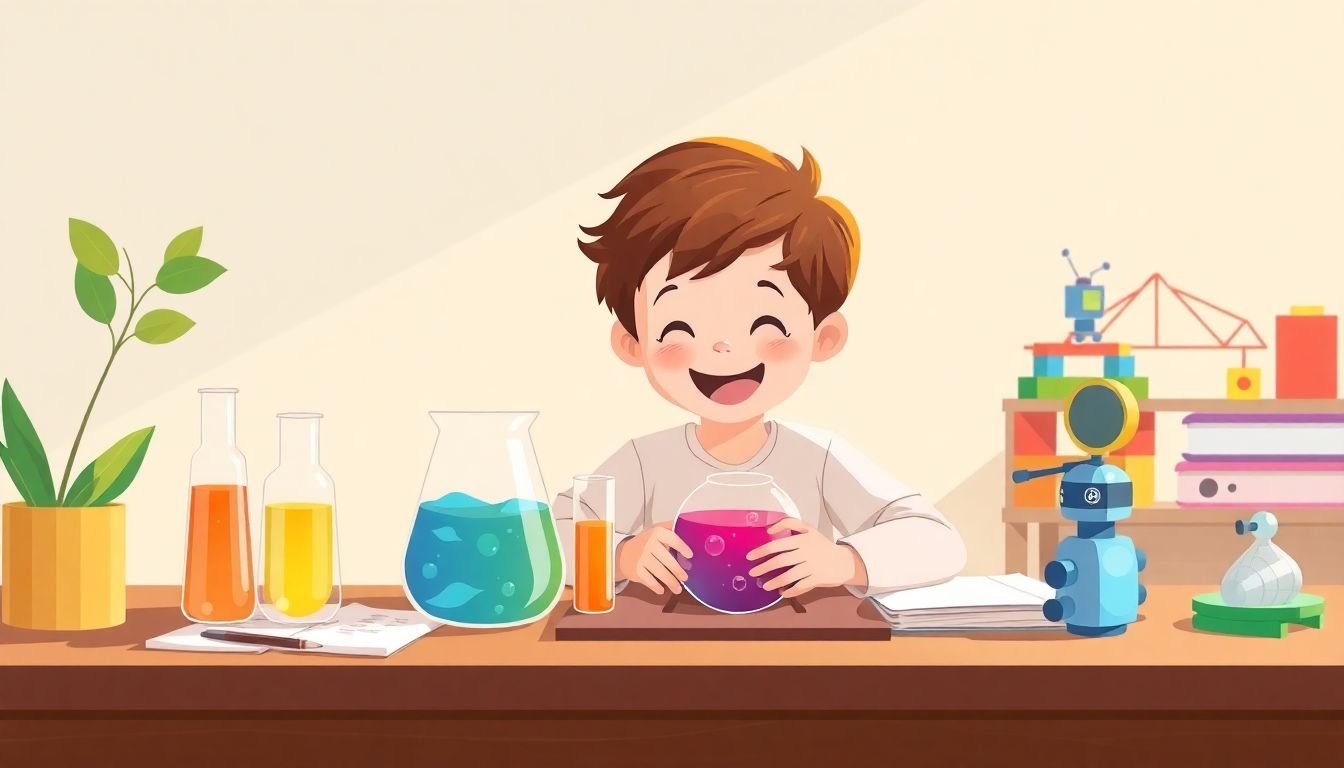Are you struggling to come up with exciting STEM project ideas? You’re definitely not alone! Many parents and teachers often find it challenging to brainstorm fun and engaging projects that spark creativity and interest in science, technology, engineering, and math.
But here’s the good news: if you stick around, you’ll discover a treasure trove of project prompts that can ignite that STEM spark in kids and teens alike. From hands-on experiments to creative activities, there’s something for everyone.
Get ready to dive into a range of STEM project ideas, perfect for kids, high school students, college students, and even fun activities you can try at home. Let’s get those creative juices flowing!
Key Takeaways
- Generate fun and engaging STEM project ideas suitable for various age groups using ChatGPT prompts.
- Explore hands-on projects for kids like homemade volcanoes and solar ovens that make learning enjoyable.
- Encourage high school students with challenges like building model rockets or coding simple games.
- Involve college students in complex projects like autonomous robots and community-focused mobile apps.
- Integrate STEM activities into family life with garden projects and DIY science experiments at home.
- Focus on engineering and robotics prompts to inspire innovation through hands-on challenges.
- Engage students in environmental science by conducting nature hunts and composting projects.

STEM Project Ideas Prompts for ChatGPT
Looking for creative STEM project ideas? ChatGPT can help you generate innovative prompts tailored to any age group or skill level.
Here are some effective commands you can use to explore STEM projects with ChatGPT:
- Generate 5 unique STEM project ideas for elementary school students that focus on hands-on learning.
- Provide a list of advanced STEM project prompts for high school students interested in physics and engineering.
- Suggest interactive STEM activities that can be done at home with everyday materials.
- Create innovative engineering and robotics project prompts suitable for middle school students.
By using these prompts, you can easily kickstart engaging projects that inspire curiosity and learning.
Creative STEM Project Ideas for Kids
Getting kids excited about STEM can be simple with the right projects. Here are some kid-friendly STEM activities that blend fun with education.
1. Build a simple volcano using baking soda and vinegar to explore chemical reactions.
2. Create a homemade compass using a needle and a magnet to teach kids about navigation.
3. Design a DIY catapult to demonstrate principles of physics while encouraging imaginative play.
4. Conduct a “rain in a jar” experiment using jars, water, and shaving cream to visualize weather patterns.
5. Use a cardboard box to make a solar oven and cook s’mores under the sun while learning about solar energy.
These activities are not only engaging but also educational, fostering a love for science and exploration.
STEM Project Prompts for High School Students
High school students often seek projects that challenge their understanding of complex topics. Here are some advanced STEM project prompts to inspire your teens.
Create a proposal for designing a sustainable community garden focusing on environmental science and community engagement.
Investigate the principles of aerodynamics by building model rockets and analyzing their flight patterns.
Develop a coding project that makes a simple game using Python or Java, integrating math and computer science.
Compose a research paper on renewable energy technologies and present a working model or prototype.
Perform a statistical analysis of students’ study habits and their effects on academic performance using surveys.
Each of these projects encourages critical thinking, creativity, and collaboration.
Fun STEM Projects for College Students
College students thrive on collaborative, hands-on projects. Here are some fun STEM project ideas specifically designed for university-level learning.
Form a team to build an autonomous robot that can navigate a specific course, applying principles of engineering and robotics.
Conduct a research project analyzing the impacts of climate change on local ecosystems using field studies and data collection.
Create a mobile app that addresses a community issue, blending technology and social responsibility.
Design a 3D-printed prototype of an innovative product solving a real-world problem.
Host a hackathon to develop software solutions for educational challenges, encouraging teamwork and creativity.
These projects not only build technical skills but also foster teamwork and effective communication among students.

Hands-On STEM Activities for the Classroom
Implementing hands-on STEM activities in the classroom can foster an engaging learning environment.
Start with the classic egg drop challenge where students design a container to protect an egg from a fall.
Conduct a bridge-building competition using spaghetti and marshmallows to teach structural engineering concepts.
Introduce coding with programmable robots, allowing students to navigate mazes they create themselves.
Create a mini science fair, where students can choose their topics and present experiments or findings to their peers.
Use interactive simulations to demonstrate physics principles like momentum and energy conservation.
These activities promote teamwork and practical problem-solving skills, making STEM subjects more relatable.
Ideas for Integrating STEM Projects at Home
Integrating STEM projects into family life can make learning a fun and collaborative experience.
Try launching simple homemade rockets using film canisters and vinegar, setting off friendly family competitions.
Create a vegetable garden together and use it as a springboard to learn about plant biology and ecosystems.
Incorporate math by measuring ingredients while baking, discussing fractions and proportions in a tasty way.
Set up a DIY science lab in your kitchen with everyday ingredients for experiments like making slime or exploring reactions.
Use online resources like ChatGPT by typing commands such as “Generate 5 STEM activities for families with kids aged 6-12.”
These activities nurture curiosity and critical thinking, making STEM a regular part of home life.
Engineering and Robotics Project Prompts
Exploring engineering and robotics can be both educational and exciting for students.
Challenge students to design a water filtration system using common materials to learn about environmental engineering.
Encourage them to program a robot to accomplish simple tasks, focusing on the fundamentals of coding and robotics.
Have students create a Rube Goldberg machine to illustrate complex problem-solving and mechanics in action.
Prompts like “Suggest 3 engineering challenges for middle school students” can generate fresh project ideas for ChatGPT users.
Students can also build a hovercraft using a CD and a balloon to understand concepts of friction and air pressure.
Such projects provide hands-on experiences that develop engineering skills and inspire innovation.
Environmental Science STEM Project Ideas
Environmental science projects engage students while promoting awareness of sustainability and ecology.
Start with a nature scavenger hunt where students identify various plant species in their local environment.
Create a compost bin in the classroom to illustrate waste management and nutrient recycling.
Conduct water testing on local streams or ponds to analyze pH levels and other characteristics.
Use commands like “List 5 environmental science projects for high school students” in ChatGPT for additional inspiration.
Encourage students to create a poster campaign on climate change and its impact on local wildlife.
These projects not only enhance understanding but also encourage stewardship of the environment.

Mathematics-Related Project Prompts
Mathematics can be engaging and fun when applied to real-world scenarios through creative projects.
Challenge students to create a budget for a hypothetical event, allowing them to practice addition, subtraction, and percentages.
Ask students to collect data on their favorite sports or hobbies and analyze statistics to determine trends or averages.
Encourage kids to design geometric garden layouts using concepts of area and perimeter, giving them a practical view of math.
Use commands like “Generate 5 interactive math project ideas for high school students” to get inspired by ChatGPT.
Have students create a math board game that incorporates strategy and problem-solving skills; they can test it in groups.
These projects help students see the fun in math and how it applies to everyday life.
Science Experiment Ideas for STEM Learning
Science experiments are a fantastic way to foster curiosity and critical thinking in STEM learning.
Conduct the classic baking soda and vinegar volcano to explore chemical reactions and gas production.
Create a solar oven using a pizza box and foil to demonstrate solar energy; use it to melt s’mores for a tasty treat.
Set up a chromatography experiment using coffee filters and markers to separate colors, visually illustrating science concepts.
Type “List 5 fun science experiments for middle school students” in ChatGPT to discover more exciting ideas.
Encourage students to observe the factors affecting plant growth by setting up an experiment with different light conditions.
These experiments not only enhance understanding but also spark a lasting interest in science.
Technology Projects to Enhance Learning
Integrating technology into STEM projects can boost engagement and learning outcomes for students.
Encourage students to develop a website that serves a community need; they’ll learn coding while addressing real-world issues.
Task them with creating a digital presentation on emerging technologies and their potential impacts on society.
Utilize apps and software to simulate scientific models, perhaps exploring ecosystems or chemical reactions virtually.
Use ChatGPT to generate prompts like “Suggest 5 technology projects for college students in computer science” for innovative ideas.
Host a coding challenge where students create a simple app or game, promoting teamwork and problem-solving skills.
Technology projects like these prepare students for a future where digital literacy is essential.
FAQs
Easy STEM projects for kids include building simple bridges with straws, creating a volcano using baking soda and vinegar, and making homemade slime. These projects engage young learners and introduce essential science and engineering principles.
High school students benefit from STEM projects by enhancing critical thinking, problem-solving, and teamwork skills. These projects often mirror real-world challenges, making learning relevant and preparing them for future careers in technology and engineering.
Engaging STEM activities for the classroom include hands-on science experiments, robotics challenges, and math games. Incorporating technology, such as coding or digital simulations, can also make the learning experience interactive and enjoyable for students.
STEM projects can be integrated at home by engaging in simple experiments, building structures with household items, or using educational apps. Parents can encourage curiosity by exploring science concepts during everyday activities like cooking or gardening.
